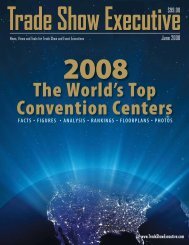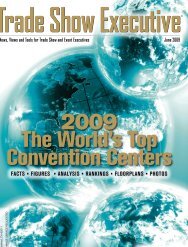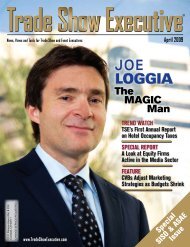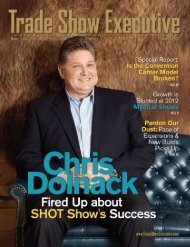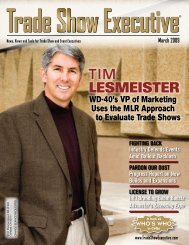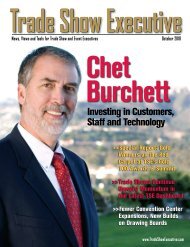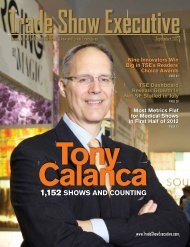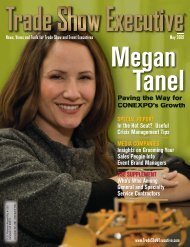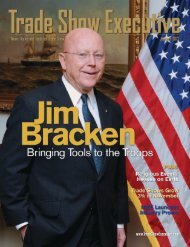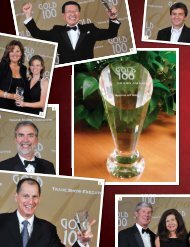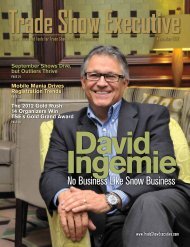the September 2008 Issue in PDF Format - Trade Show Executive
the September 2008 Issue in PDF Format - Trade Show Executive
the September 2008 Issue in PDF Format - Trade Show Executive
You also want an ePaper? Increase the reach of your titles
YUMPU automatically turns print PDFs into web optimized ePapers that Google loves.
Bob: Reed Exhibitions Worldwide<br />
has experienced phenomenal growth<br />
under your leadership. How have you<br />
structured <strong>the</strong> company to achieve<br />
this?<br />
Mike: First and foremost, we are<br />
comprised of local teams serv<strong>in</strong>g local<br />
markets, which need to be quick, adaptive<br />
and entrepreneurial. Our competition is<br />
often not from o<strong>the</strong>r large organizers, but<br />
ra<strong>the</strong>r from local and national companies.<br />
We have regional presidents cover<strong>in</strong>g <strong>the</strong><br />
world, report<strong>in</strong>g to me, as well as offices<br />
<strong>in</strong> 39 countries with 2,600 employees<br />
runn<strong>in</strong>g 500 shows.<br />
Bob: What is your revenue breakdown,<br />
vis-à-vis organic growth, acquisitions<br />
and launches?<br />
Mike: Revenue <strong>in</strong>creased 42% over <strong>the</strong><br />
last four years. That breaks down to<br />
38% organic growth, 12% launch, 15%<br />
acquisition and 23% go<strong>in</strong>g <strong>the</strong> o<strong>the</strong>r way<br />
-- divested bus<strong>in</strong>ess.<br />
Bob: Do you have an <strong>in</strong>-house<br />
“Incubator Team” for acquisitions?<br />
Mike: Not really. We average about 8 to<br />
10 acquisitions a year, <strong>in</strong>vest<strong>in</strong>g between<br />
U.S.$150 to 200 million annually. We have<br />
a central team here that acts as a filter<br />
for 20 or 40 different properties that we<br />
are constantly evaluat<strong>in</strong>g, which <strong>in</strong>cludes<br />
f<strong>in</strong>ancial, legal, etc. In <strong>the</strong> majority of<br />
cases, however, <strong>the</strong> management teams<br />
around <strong>the</strong> world drive our acquisitions –<br />
it’s truly a “flow up” system.<br />
Bob: What about enter<strong>in</strong>g new markets<br />
or territories?<br />
Mike: A team that reports to our<br />
commercial director does <strong>the</strong> bigger<br />
deals here and I get <strong>in</strong>volved with f<strong>in</strong>al<br />
approval.<br />
Bob: What do you look for primarily?<br />
Mike: We’re after a strategic fit with <strong>the</strong> 47<br />
<strong>in</strong>dustry sectors where we have developed<br />
– or are develop<strong>in</strong>g – a global event<br />
network. We acquire for <strong>the</strong> long term,<br />
unlike many bus<strong>in</strong>esses funded by venture<br />
capital, which look for a three to five-year<br />
return. We look as far out as<br />
we can, comforted by Reed<br />
Elsevier’s f<strong>in</strong>ancial back<strong>in</strong>g.<br />
We are constantly seek<strong>in</strong>g<br />
high quality, market-lead<strong>in</strong>g<br />
events with good susta<strong>in</strong>able<br />
growth as well as excellent<br />
management.<br />
Bob: How important is <strong>the</strong><br />
management team <strong>in</strong> an<br />
acquisition?<br />
Mike: One of <strong>the</strong> th<strong>in</strong>gs that<br />
could be a deal breaker is <strong>the</strong><br />
quality of <strong>the</strong> management<br />
team and whe<strong>the</strong>r <strong>the</strong>y will<br />
stay on board. I would be<br />
less <strong>in</strong>terested <strong>in</strong> an event or<br />
company if we felt that with<strong>in</strong><br />
six months, we could lose those<br />
people who developed that bus<strong>in</strong>ess and<br />
have <strong>the</strong> market reputation, knowledge<br />
and <strong>in</strong>telligence. We have been very<br />
fortunate <strong>in</strong> most of our acquisitions to<br />
reta<strong>in</strong> <strong>the</strong> management. Also, I am always<br />
<strong>in</strong>terested <strong>in</strong> opportunities where we can<br />
add to our own management team.<br />
Bob: What about your launches? How<br />
quickly can you tap <strong>in</strong>to a new market<br />
opportunity?<br />
Mike: Ideally, we look at a m<strong>in</strong>imum<br />
launch time of 12 months out, but<br />
preferably 18 months out. We have<br />
launched a few shows <strong>in</strong> six months’ time<br />
to ga<strong>in</strong> a competitive edge or when our<br />
research identified a strong immediate<br />
need.<br />
Bob: How many shows do you launch<br />
each year?<br />
Mike: Historically, we have launched<br />
between 30 to 40 new shows a year. This<br />
year, we’re probably go<strong>in</strong>g to launch<br />
25 to 28 events that will come from<br />
our show teams <strong>in</strong> particular markets.<br />
Approximately 50% will be brand<br />
extensions. We’re also look<strong>in</strong>g seriously<br />
at green <strong>the</strong>mes.<br />
Bob: Can you give an example of a<br />
brand extension <strong>in</strong> a new region?<br />
Top of <strong>the</strong>ir Game. Mike Rusbridge (right) and Alastair Gornall,<br />
chief executive of Reed Exhibitions UK (left), are part of a team<br />
that has built <strong>the</strong> $1.4 billion company.<br />
Mike: Virtually our entire manufactur<strong>in</strong>g<br />
portfolio has been migrated to Asia or<br />
<strong>the</strong> BRIC economies. We now have 40<br />
events <strong>in</strong> Ch<strong>in</strong>a, <strong>in</strong>clud<strong>in</strong>g electronic<br />
manufactur<strong>in</strong>g, packag<strong>in</strong>g and o<strong>the</strong>rs that<br />
began elsewhere. We’ve done this by<br />
track<strong>in</strong>g major <strong>in</strong>dustry shifts and moved<br />
our events accord<strong>in</strong>gly. Tim<strong>in</strong>g used to<br />
be quite flexible, but today’s w<strong>in</strong>dow for<br />
accept<strong>in</strong>g an event is quite precise.<br />
Bob: I have observed that this<br />
migration has been <strong>in</strong>tegral to your<br />
success over <strong>the</strong> years.<br />
Mike: Look<strong>in</strong>g at <strong>the</strong> West, mean<strong>in</strong>g <strong>the</strong><br />
U.S. and Europe, versus <strong>the</strong> rest of <strong>the</strong><br />
world, Asia and <strong>the</strong> BRIC countries were<br />
9% of our total bus<strong>in</strong>ess 10 years ago.<br />
Today, <strong>the</strong>y are over 20% and will grow to<br />
30% with<strong>in</strong> <strong>the</strong> next few years. Ano<strong>the</strong>r<br />
part of our success is <strong>the</strong> ability to see<br />
th<strong>in</strong>gs multi-dimensionally and def<strong>in</strong>e<br />
what <strong>in</strong>dustry sectors and geographies<br />
we want to be <strong>in</strong> and <strong>the</strong>n create events<br />
where our skills match <strong>the</strong>se goals. I<br />
th<strong>in</strong>k we’re good at do<strong>in</strong>g this.<br />
Bob: What are <strong>the</strong> ma<strong>in</strong> global<br />
challenges to Reed Exhibitions today?<br />
Mike: Be<strong>in</strong>g <strong>in</strong> 47 <strong>in</strong>dustry sectors and 38<br />
countries gives you a greater resilience to<br />
<strong>the</strong> vagaries of <strong>the</strong> economy. Short of<br />
everyth<strong>in</strong>g be<strong>in</strong>g down, as it was back <strong>in</strong><br />
Cont<strong>in</strong>ued on page 22<br />
www.<strong>Trade</strong><strong>Show</strong><strong>Executive</strong>.com <strong>Trade</strong> <strong>Show</strong> <strong>Executive</strong> <strong>September</strong> <strong>2008</strong> 21



